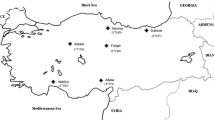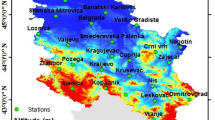Abstract
Water is a scarce resource on the earth, and the study of variability in precipitation is necessary for solving the issues related to water. Proper understanding of trends in annual precipitation is crucial for better management of available water sources. In the current study, the Mann–Kendall (MK) and innovative trend analysis (ITA) methods were used to detect the trends in annual rainfall for 30 synoptic stations and different meteorological subdivisions for the period of 1951–2020 for Karnataka, India. The significance of trend is also identified using the MK trend test. Furthermore, the entire time series data were classified into three sub groups to recognize the monotonic trend components based on the ITA method. The results of the MK trend test indicated that, in the first half of the time series data more stations showed decreasing trend, while in the second half, an increasing trend in annual precipitation was observed for most of the stations. In the ITA method, except for four stations, all the stations detected a significantly positive trend in annual precipitation. The spatially distributed trend for precipitation pattern for the total time series data showed the highest positive and negative trends in the southern and northern parts of the state, respectively. Six stations, namely, Bidar, Dakshina Kannada, Dharwad, Kalburgi, Udupi, and Vijayapura, exhibited instability in calculated trends. In the analysis of monotonic trends, only six stations showed monotonic trend components, while the other 24 stations and subdivisions are non-monotonic. In the current study, it was concluded that the ITA method is more sensitive than the MK trend test for detecting hidden trends.





Similar content being viewed by others
Availability of data and materials
The data are available from the corresponding author upon request.
References
Achite M, Ceribasi G, Wałęga A, Ceyhunlu AI, Elshaboury N, Krakauer N, Hartani T, Caloiero T, Gul S (2023) Analysis of monthly average precipitation of Wadi Ouahrane basin in Algeria by using the ITRA, ITPAM, and TPS methods. Environ Monit Assess 195(5):606
Adarsh S, Reddy MJ (2015) Trend analysis of rainfall in four meteorological subdivisions of southern India using nonparametric methods and discrete wavelet transforms. Int J Climatol 35:1107–1124
Ahmad I, Zhang F, Tayyab M, Anjum M, Zamam M, Liu J, Farid U, Saddique Q (2018) Spatiotemporal analysis of precipitation variability in annual, seasonal, and extreme values over upper Indus River basin. Atmos Res 213:346–360
Alashan S (2018) An improved version of innovative trend analyses. Arab Geosci. https://doi.org/10.1007/s12517-018-3393-x
Alifujiang Y, Abuduwaili J, Maihemuti B, Emin B, Groll M (2020) Innovative trend analysis of precipitation in the lake issyk-kulbasin Kyrgyzstan. Atmosphere 11:332
Amiri Arab Mohammad and Milan Gocic (2021) Innovative trend analysis of annual precipitation in Serbia during 1946–2019. Environm Earth Sci 80:777. https://doi.org/10.1007/s12665-021-10095
Ay M, Kisi O (2015) Investigation of trend analysis of monthly total precipitation by an innovative method. Theoret Appl Climatol 120:617–629
Caloiero T (2019) Evaluation of rainfall trends in the South Island of New Zealand through the innovative trend analysis (ITA). Theor Appl Climatol 139:493–504
Cengiz TM, Tabari H, Onyutha C, Kisi O (2020) Combined use of graphical and statistical approaches for analyzing historical precipitation changes in the Black Sea region of Turkey. Water 12:705
Ceribasi G (2018) Analysis of rainfall datas of the west black sea basin by innovative sen method. Aca Plat J Eng Sci 6:168–173. https://doi.org/10.21541/apjes.431965
Chowdari KK, Deb Barma S, Bhat N, Girisha R, Gouda KC, Mahesha A (2023) Trends of seasonal and annual rainfall of semi-arid districts of Karnataka, India: application of innovative trend analysis approach. Theor Appl Climatol 152(1–2):241–264
Da Silva RM, Santos CAG, Moreira M, Corte-real J, Silva VCL, Medeiros IC (2015) Rainfall and river low trends using Mann Kendall and Şen’s slope estimator statistical tests in the Cobres River basin. Nat Hazards 77:1205–1221. https://doi.org/10.1007/s11069-015-1644-7
Eslami-Andargoli L, Dale P, Sipe N, Chaseling J (2009) Mangrove expansion and rainfall patterns in Moreton Bay, Southeast Queensland Australia. Estuar Coast Shelf Sci 85:292–298
Gocic M, Trajkovic S (2013) Analysis of changes in meteorological variables using Mann-Kendall and Şen’s slope estimator statistical tests in Serbia. Global Planet Change 100(1):172–182
Güçlü YS (2018) Multiple Şen-innovative trend analyses and partial Mann-Kendall test. J Hydrol 566:685–704
Güçlü YS, Sisman E, Dabanli I (2020) Innovative triangular trend analysis. Arab J Geosci 13:27
He X, Guan HD, Zhang XP, Simmons CTA (2014) Wavelet-based multiple linear regression model for forecasting monthly rainfall. Int J Climatol 34:1898–1912
Jain SK, Kumar V, Saharia M (2013) Analysis of rainfall and temperature trends in northeast India. Int J Climatol 33:968–978. https://doi.org/10.1002/joc.3483
Jayasree V, Venkatesh B (2015) Analysis of rainfall in assessing the drought in semi-arid region of Karnataka State, India. Water Resour Manag 29:5613–5630. https://doi.org/10.1007/s11269-015-1137-1
Kendall MG (1970) Rank Correlation Methods, 4th edn. Griffin, London
Kendall (2016) Spearman’s rho tests and ARIMA model. Meteorol Atmos Phys https://doi.org/10.1007/s00703016-0479-4
Kisi O (2015) An innovative method for trend analysis of monthly pan evaporations. J Hydrol 527:1123–1129
Li J, Wu W, Ye X, Jiang H (2018) Innovative trend analysis of main agriculture natural hazards in China during 1989–2014. Nat Hazards https://doi.org/10.1007/s11069-018-3514-6
Mann HB (1945) Nonparametric test against trend. Econometrica 13:245–259
Mohorji AM, Şen Z, Almazroui M (2017) Trend analyses revision and global monthly temperature innovative multi-duration analysis. Earth Syst Environ 1:9
Rahman MA, Yunsheng L, Sultana N (2016) Analysis and prediction of rainfall trends over Bangladesh using Mann–Kendall, Spearman’s rho tests and ARIMA model. Meteorol Atmos Phys https://doi.org/10.1007/s00703016-0479-4
Sang YF, Wang Z, Liu C (2014) Comparison of the MK test and EMD method for trend identification in hydrological time series. J Hydrol 510:293-298. https://doi.org/10.1016/j.jhydrol.2013.12.039
Saplioglu K, Kilit M, Yavuz BK (2014) Trend analysis of streams in the Western Mediterranean Basin of Turkey. Freşenius Environ Bull 23:313–324
Sen PK (1968) Estimates of the regression coefficient based on Kendall’s tau. J Am Stat Assoc 63(324):1379–1389
Şen Z (2012) Innovative trend analysis methodology. J Hydrol Eng 17:1042–1046
Şen Z (2017) Innovative trend significance test and applications. Theoret Appl Climatol 127:939–947
Şen Z, Sisman E, Dabanli I (2019) Innovative polygon trend analysis (IPTA) and applications. J Hydrol 575:202–210
Shafer BA, Dezman LE (1982) Development of a surface water supply index (SWSI) to assess the severity of drought conditions in snow pack runoff areas. Western Snow Conference, Colorado State University, Reno, pp. 164–175
Shahabfar A, Eitzinger J (2013) Spatio-temporal analysis of droughts in semi-arid regions by using meteorological drought indices. Atmosphere 4(2):94–112
Singh RN, Sah S, Das B, Potekar S, Chaudhary A, Pathak H (2021) Innovative trend analysis of spatio-temporal variations of rainfall in India during 1901–2019. Theoret Appl Climatol 145(1–2):821–838
Wang Z, Liu C (2014) Comparison of the MK test and EMD method for trend identification in hydrological time series. J Hydrol 510:293–298
Wu H, Qian H (2017) Innovative trend analysis of annual and seasonal rainfall and extreme values in Shaanxi, China, since the 1950s. Int J Climatol 37(5):2582–2592
Yue S, Pilon P, Phinney B, Cavadias G (2002) The influence of autocorrelation on the ability to detect trend in hydrological series. Hydrol Process 16:1807–1829. https://doi.org/10.1002/hyp.1095
Zelenáková M, Vido J, Portela MM, Purcz P, Blištán P, Hlavatá H, Hluštík P (2017) Precipitation trends over Slovakia in the period 1981–2013. Water 9:922. https://doi.org/10.3390/w9120922
Zhang X, Zwiers F, Hegerl G, Lambert F, Gillett N, Solomon S, Stott P, Nozawa T (2007) Detection of human influence on twentieth century precipitation trends. Nature 448(7152):461–465
Zhou Z, Wang L, Lin A, Zhang M, Niu Z (2018) Innovative trend analysis of solar radiation in China during 1962–2015. Renew Energ 119:675–689
Funding
This research was carried out without any external funding.
Author information
Authors and Affiliations
Contributions
PG Data collection, prepared methodology part and manuscript writing, SS conceptualized the manuscript, did supervision and correction of manuscript GRK analysis of data with different software. KNM references and draft, BD formal analysis and codes.
Corresponding author
Ethics declarations
Conflict of interest
The authors have no conflict of interest.
Additional information
Publisher's Note
Springer Nature remains neutral with regard to jurisdictional claims in published maps and institutional affiliations.
Rights and permissions
Springer Nature or its licensor (e.g. a society or other partner) holds exclusive rights to this article under a publishing agreement with the author(s) or other rightsholder(s); author self-archiving of the accepted manuscript version of this article is solely governed by the terms of such publishing agreement and applicable law.
About this article
Cite this article
Gopakkali, P., Sridhara, S., Kashyap, G.R. et al. Trend detection of annual precipitation of Karnataka, India during 1951–2020 based on the innovative trend analysis method. Environ Earth Sci 82, 551 (2023). https://doi.org/10.1007/s12665-023-11239-w
Received:
Accepted:
Published:
DOI: https://doi.org/10.1007/s12665-023-11239-w




